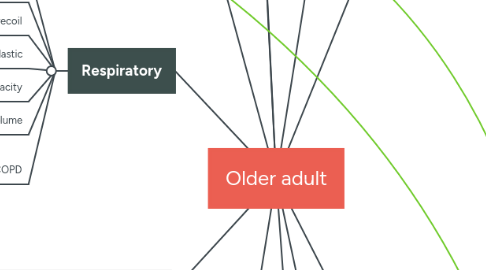
1. Rest and sleep
1.1. Phase advance
1.2. More time in phases I and II, less in stages III and IV
1.3. Less sound sleep
1.4. Sleep disturbances
1.4.1. Insomnia
1.4.2. Nocturnal myoclonus
1.4.3. Restless leg syndrome
1.4.3.1. Associated with iron deficiency anemia, uremia, Parkinson’s disease, rheumatoid arthritis, diabetes, neurological lesions
1.4.4. Sleep apnea
2. Urinary elimination
2.1. Hypertrophy and thickening of bladder muscle
2.1.1. Reduced storage
2.1.2. Frequency
2.1.3. Nocturia
2.2. Changes in cortisol control of micturation
2.3. Decreased neurological control of bladder emptying
2.4. Retention of large volumes of urine
2.4.1. Female: fecal impaction
2.4.2. Male: prostatic hypertrophy
2.5. Kidney filtration decreased
2.5.1. Affects the ability to eliminate drugs
2.5.2. Potential for adverse drug rxns
2.6. Reduced renal function
2.6.1. High blood urea nitrogen and creatinine levels
2.7. Decreased tubular function
2.8. Increase in renal threshold for glucose
2.9. Urinary incontinence
2.9.1. NOT normal aging
2.9.2. Risk increased for older adults r/t age related changes
2.9.3. Many different forms
3. Cardiac
3.1. Heart valves become thicker and rigid
3.2. Aorta becomes dialated
3.2.1. Slight ventricular hypertrophy
3.2.2. Thicken left ventricular wall
3.3. Myocardial muscle less efficient
3.3.1. Decreased contractile strength
3.3.2. Decreased CO when demands increased
3.4. Calcification, reduced elasticity of vessels
3.5. Less sensitive to baroreceptor regulation of BP
3.6. Congestive heart failure
3.6.1. Coronary artery disease r/t most cases
3.6.2. Arteriosclerosis, high blood pressure
4. Respiratory
4.1. Reduce cough
4.2. Reduced weight and size of lungs
4.3. Decreased elastic recoil
4.4. Alveoli less elastic
4.5. Reduced vital capacity
4.6. Increased residual volume
4.7. COPD
4.7.1. Emphysema
4.7.1.1. Destruction and enlargement of alveoli
4.7.1.1.1. Decreases the amount of surface area and oxygen that gets into blood stream
4.7.2. Bronchitis
4.7.2.1. Increased mucus and inflammation
5. Nutrition and hydration
5.1. Decreased need for calories
5.2. Decreased thirst perception
5.3. Basal metabolic rate declines
5.4. Intracellular fluid lost
6. GI
6.1. Atrophy of tongue decreased taste perception
6.2. Saliva decreases
6.2.1. Swallowing may be difficult
6.3. Presbyesophagus
6.4. Decreased elasticity of stomach
6.5. Higher pH in stomach
6.5.1. Decline in HCl production and pepsin
6.5.2. Interferes with protein absorption
6.5.3. Increase in gastric irritation
6.6. Fewer cells on absorption surface of intestinal wall
6.7. Slower peristalsis
6.8. Increased risk of constipation
6.9. Bile salt synthesis decreases
6.10. Pancreas changes effect fat absorption
6.11. Hiatal hernia
6.11.1. Part of stomach pushes us through diaphragm
6.11.1.1. Often associated with heartburn
6.11.1.2. Presents as pain in abdomen
7. Musculoskeletal
7.1. Decline in size and number of muscle fibers
7.1.1. Sarcopenia
7.1.1.1. Reduction in protein synthesis and increase in protein degeneration
7.2. Reduced flexibility r/t CT changes
8. Sexuality
8.1. Andropause
8.1.1. Does not occur in all men
8.1.2. Breast enlargement
8.1.3. Osteopenia
8.1.4. Osteoporosis
8.1.5. Shrinkage of testes
8.2. Menopause
8.3. Dyspareunia
8.4. Erectile dysfunction
8.4.1. Common but NOT normal aging
9. Reproductive
9.1. Women
9.1.1. Vuvla, cervix, uterus, fallopian tubes atrophy
9.1.2. Flatten labia
9.1.3. Loss of subcutaneous fat and hair
9.1.4. Vaginal epithelium thins
9.1.5. Vaginal canal
9.1.5.1. Decreased collagen and adipose tissue
9.1.5.2. Canal narrow and shorten
9.1.5.3. Less lubrication
9.1.5.4. More alkaline vaginal pH
9.1.6. Uterus and ovaries decrease in size
9.1.7. Fallopian tubes shorten and straighten
9.1.8. Breasts sag and less firm
9.1.9. Some retraction of nipples
9.2. Men
9.2.1. Seminal vesicles epithelium thins
9.2.2. Decreased capacity to retain fluids
9.2.3. Seminiferous tubules changes
9.2.4. Prostate gland enlargement
10. Nervous
10.1. Loss of nerve cell mass
10.2. Decreased dendrites
10.3. Demyelination
10.4. Slower reaction times
10.5. Decrease cerebral blood flow
10.6. Fatty deposits in vessels
10.7. Free radicals accumulate
10.8. Slowing in central processing
10.9. Decline in cranial nerves affecting taste and smell
10.10. PD
10.10.1. Might be caused by low dopamine levels
10.10.2. Tremors, shuffling gait, stiffness, constipation
